Zhenjiang Li
EmbedGenius: Towards Automated Software Development for Generic Embedded IoT Systems
Dec 12, 2024



Abstract:Embedded IoT system development is crucial for enabling seamless connectivity and functionality across a wide range of applications. However, such a complex process requires cross-domain knowledge of hardware and software and hence often necessitates direct developer involvement, making it labor-intensive, time-consuming, and error-prone. To address this challenge, this paper introduces EmbedGenius, the first fully automated software development platform for general-purpose embedded IoT systems. The key idea is to leverage the reasoning ability of Large Language Models (LLMs) and embedded system expertise to automate the hardware-in-the-loop development process. The main methods include a component-aware library resolution method for addressing hardware dependencies, a library knowledge generation method that injects utility domain knowledge into LLMs, and an auto-programming method that ensures successful deployment. We evaluate EmbedGenius's performance across 71 modules and four mainstream embedded development platforms with over 350 IoT tasks. Experimental results show that EmbedGenius can generate codes with an accuracy of 95.7% and complete tasks with a success rate of 86.5%, surpassing human-in-the-loop baselines by 15.6%--37.7% and 25.5%--53.4%, respectively. We also show EmbedGenius's potential through case studies in environmental monitoring and remote control systems development.
Rapid and Accurate Diagnosis of Acute Aortic Syndrome using Non-contrast CT: A Large-scale, Retrospective, Multi-center and AI-based Study
Jun 25, 2024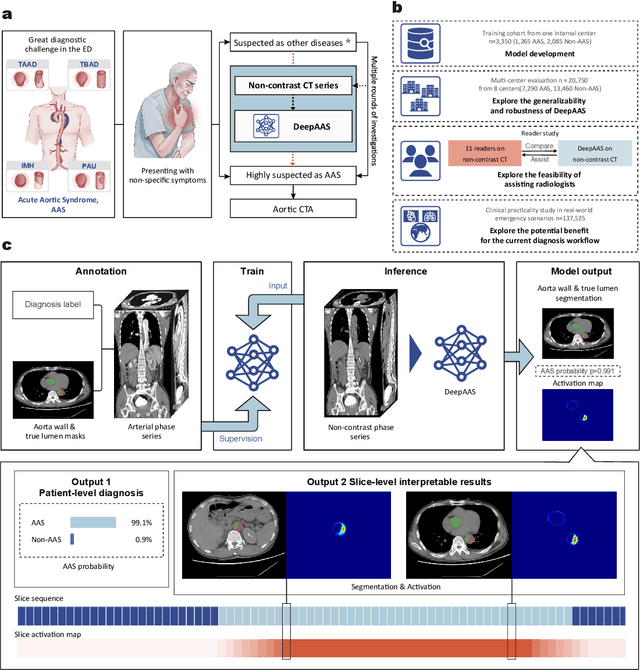
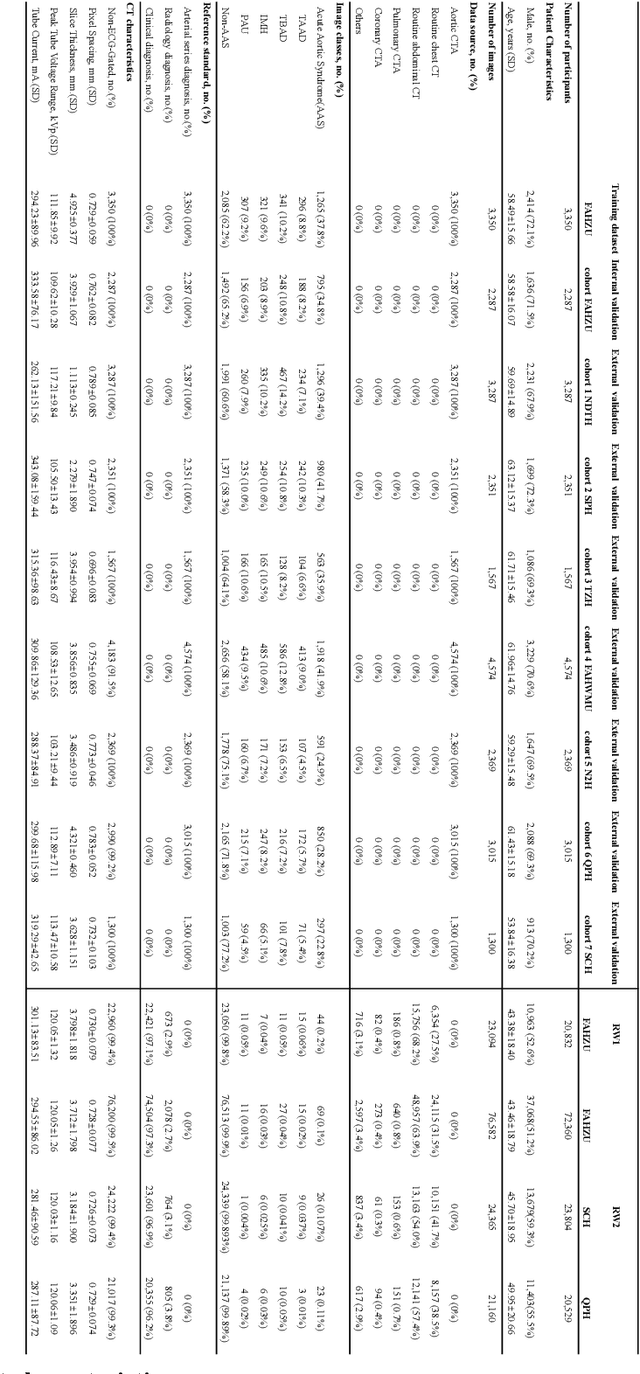
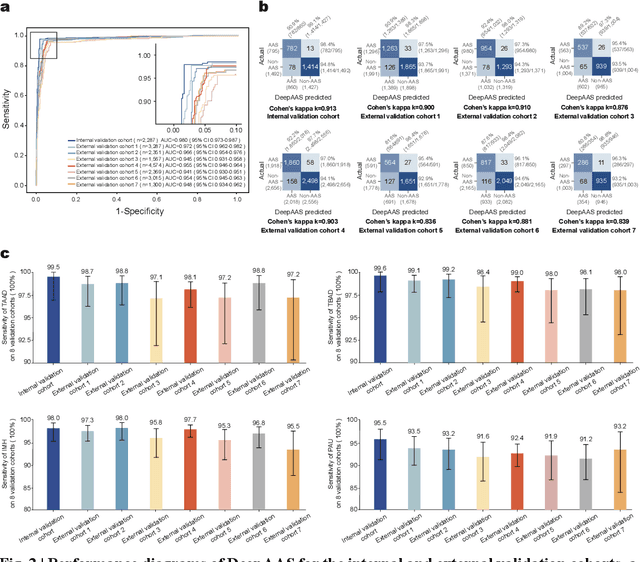
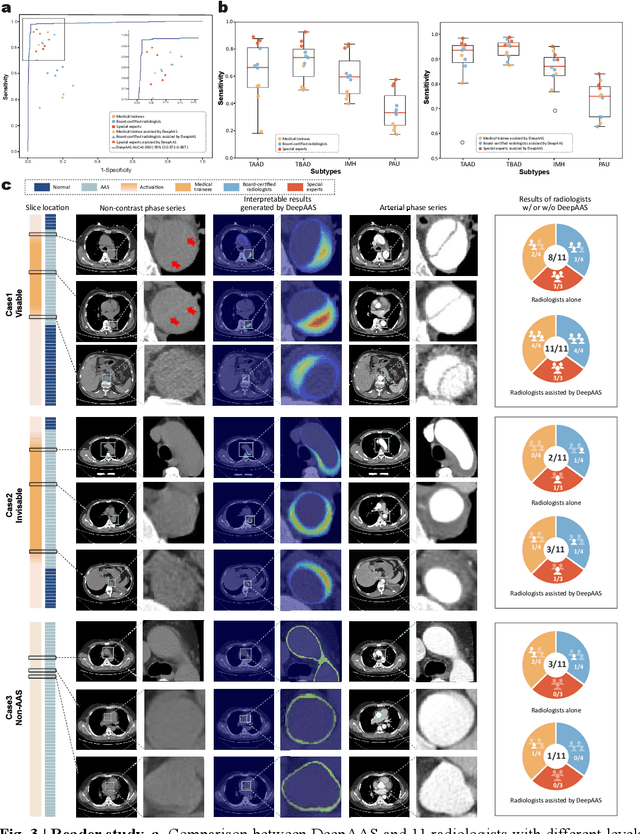
Abstract:Chest pain symptoms are highly prevalent in emergency departments (EDs), where acute aortic syndrome (AAS) is a catastrophic cardiovascular emergency with a high fatality rate, especially when timely and accurate treatment is not administered. However, current triage practices in the ED can cause up to approximately half of patients with AAS to have an initially missed diagnosis or be misdiagnosed as having other acute chest pain conditions. Subsequently, these AAS patients will undergo clinically inaccurate or suboptimal differential diagnosis. Fortunately, even under these suboptimal protocols, nearly all these patients underwent non-contrast CT covering the aorta anatomy at the early stage of differential diagnosis. In this study, we developed an artificial intelligence model (DeepAAS) using non-contrast CT, which is highly accurate for identifying AAS and provides interpretable results to assist in clinical decision-making. Performance was assessed in two major phases: a multi-center retrospective study (n = 20,750) and an exploration in real-world emergency scenarios (n = 137,525). In the multi-center cohort, DeepAAS achieved a mean area under the receiver operating characteristic curve of 0.958 (95% CI 0.950-0.967). In the real-world cohort, DeepAAS detected 109 AAS patients with misguided initial suspicion, achieving 92.6% (95% CI 76.2%-97.5%) in mean sensitivity and 99.2% (95% CI 99.1%-99.3%) in mean specificity. Our AI model performed well on non-contrast CT at all applicable early stages of differential diagnosis workflows, effectively reduced the overall missed diagnosis and misdiagnosis rate from 48.8% to 4.8% and shortened the diagnosis time for patients with misguided initial suspicion from an average of 681.8 (74-11,820) mins to 68.5 (23-195) mins. DeepAAS could effectively fill the gap in the current clinical workflow without requiring additional tests.
SwapNet: Efficient Swapping for DNN Inference on Edge AI Devices Beyond the Memory Budget
Jan 30, 2024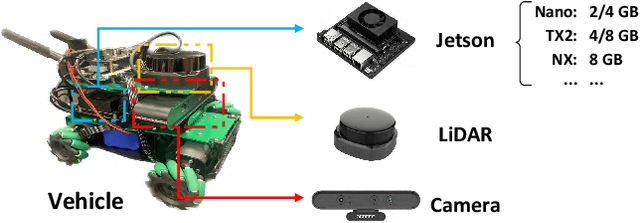
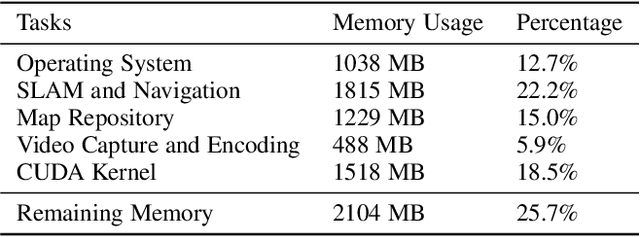
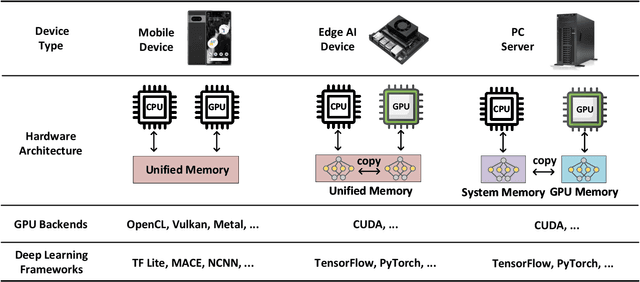
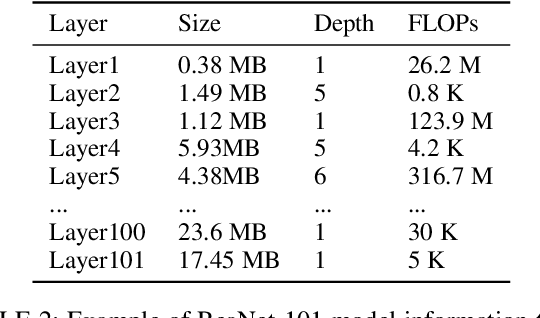
Abstract:Executing deep neural networks (DNNs) on edge artificial intelligence (AI) devices enables various autonomous mobile computing applications. However, the memory budget of edge AI devices restricts the number and complexity of DNNs allowed in such applications. Existing solutions, such as model compression or cloud offloading, reduce the memory footprint of DNN inference at the cost of decreased model accuracy or autonomy. To avoid these drawbacks, we divide DNN into blocks and swap them in and out in order, such that large DNNs can execute within a small memory budget. Nevertheless, naive swapping on edge AI devices induces significant delays due to the redundant memory operations in the DNN development ecosystem for edge AI devices. To this end, we develop SwapNet, an efficient DNN block swapping middleware for edge AI devices. We systematically eliminate the unnecessary memory operations during block swapping while retaining compatible with the deep learning frameworks, GPU backends, and hardware architectures of edge AI devices. We further showcase the utility of SwapNet via a multi-DNN scheduling scheme. Evaluations on eleven DNN inference tasks in three applications demonstrate that SwapNet achieves almost the same latency as the case with sufficient memory even when DNNs demand 2.32x to 5.81x memory beyond the available budget. The design of SwapNet also provides novel and feasible insights for deploying large language models (LLMs) on edge AI devices in the future.
DTMM: Deploying TinyML Models on Extremely Weak IoT Devices with Pruning
Jan 17, 2024Abstract:DTMM is a library designed for efficient deployment and execution of machine learning models on weak IoT devices such as microcontroller units (MCUs). The motivation for designing DTMM comes from the emerging field of tiny machine learning (TinyML), which explores extending the reach of machine learning to many low-end IoT devices to achieve ubiquitous intelligence. Due to the weak capability of embedded devices, it is necessary to compress models by pruning enough weights before deploying. Although pruning has been studied extensively on many computing platforms, two key issues with pruning methods are exacerbated on MCUs: models need to be deeply compressed without significantly compromising accuracy, and they should perform efficiently after pruning. Current solutions only achieve one of these objectives, but not both. In this paper, we find that pruned models have great potential for efficient deployment and execution on MCUs. Therefore, we propose DTMM with pruning unit selection, pre-execution pruning optimizations, runtime acceleration, and post-execution low-cost storage to fill the gap for efficient deployment and execution of pruned models. It can be integrated into commercial ML frameworks for practical deployment, and a prototype system has been developed. Extensive experiments on various models show promising gains compared to state-of-the-art methods.
Breaking the Dilemma of Medical Image-to-image Translation
Oct 13, 2021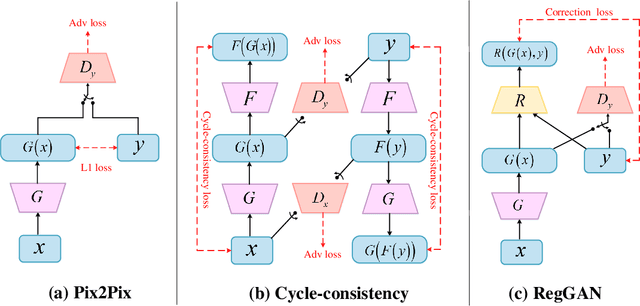
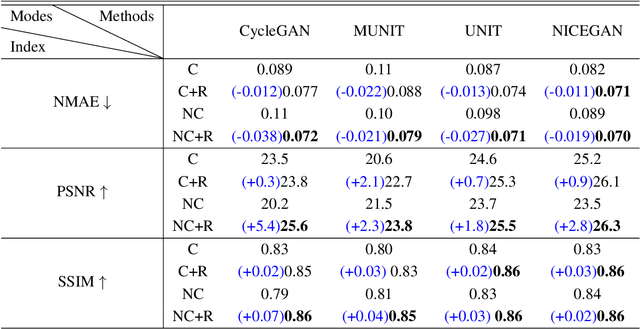
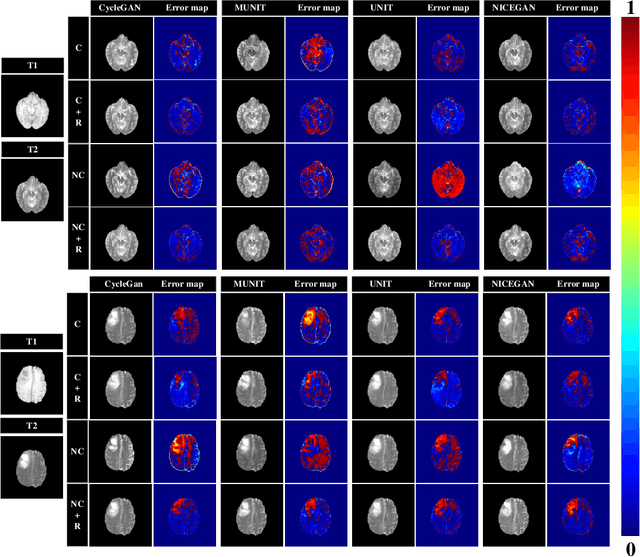
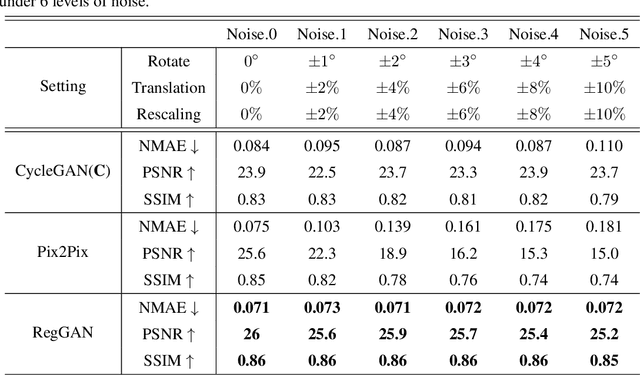
Abstract:Supervised Pix2Pix and unsupervised Cycle-consistency are two modes that dominate the field of medical image-to-image translation. However, neither modes are ideal. The Pix2Pix mode has excellent performance. But it requires paired and well pixel-wise aligned images, which may not always be achievable due to respiratory motion or anatomy change between times that paired images are acquired. The Cycle-consistency mode is less stringent with training data and works well on unpaired or misaligned images. But its performance may not be optimal. In order to break the dilemma of the existing modes, we propose a new unsupervised mode called RegGAN for medical image-to-image translation. It is based on the theory of "loss-correction". In RegGAN, the misaligned target images are considered as noisy labels and the generator is trained with an additional registration network to fit the misaligned noise distribution adaptively. The goal is to search for the common optimal solution to both image-to-image translation and registration tasks. We incorporated RegGAN into a few state-of-the-art image-to-image translation methods and demonstrated that RegGAN could be easily combined with these methods to improve their performances. Such as a simple CycleGAN in our mode surpasses latest NICEGAN even though using less network parameters. Based on our results, RegGAN outperformed both Pix2Pix on aligned data and Cycle-consistency on misaligned or unpaired data. RegGAN is insensitive to noises which makes it a better choice for a wide range of scenarios, especially for medical image-to-image translation tasks in which well pixel-wise aligned data are not available
Continuous User Authentication by Contactless Wireless Sensing
Dec 04, 2018
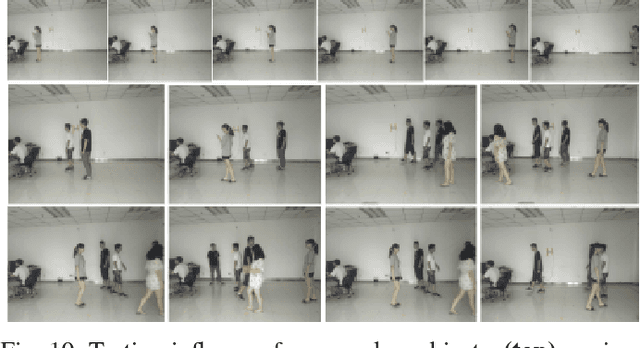
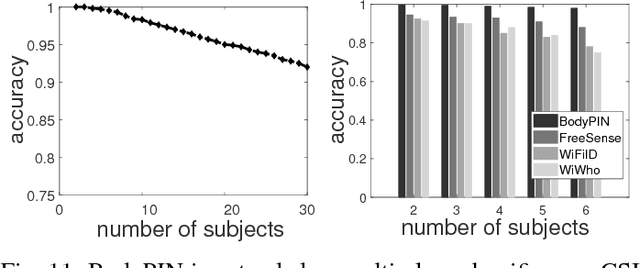
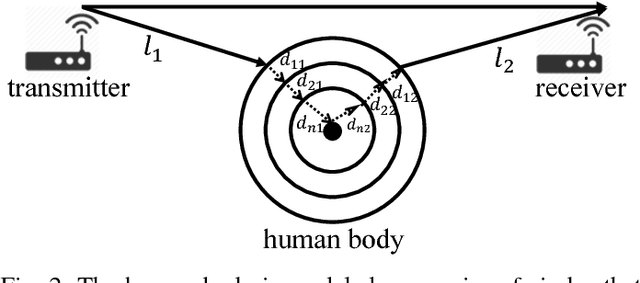
Abstract:This paper presents BodyPIN, which is a continuous user authentication system by contactless wireless sensing using commodity Wi-Fi. BodyPIN can track the current user's legal identity throughout a computer system's execution. In case the authentication fails, the consequent accesses will be denied to protect the system. The recent rich wireless-based user identification designs cannot be applied to BodyPIN directly, because they identify a user's various activities, rather than the user herself. The enforced to be performed activities can thus interrupt the user's operations on the system, highly inconvenient and not user-friendly. In this paper, we leverage the bio-electromagnetics domain human model for quantifying the impact of human body on the bypassing Wi-Fi signals and deriving the component that indicates a user's identity. Then we extract suitable Wi-Fi signal features to fully represent such an identity component, based on which we fulfill the continuous user authentication design. We implement a BodyPIN prototype by commodity Wi-Fi NICs without any extra or dedicated wireless hardware. We show that BodyPIN achieves promising authentication performances, which is also lightweight and robust under various practical settings.
 Add to Chrome
Add to Chrome Add to Firefox
Add to Firefox Add to Edge
Add to Edge